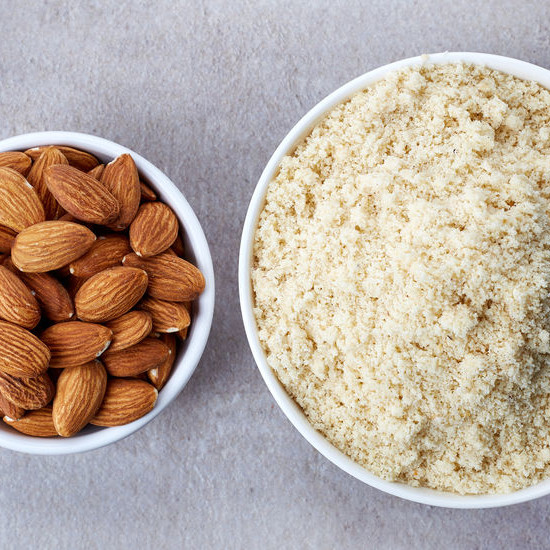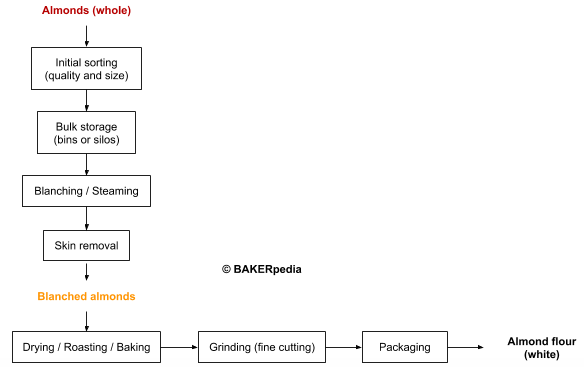
Almond Flour
What is Almond Flour?
Almond flour is simply almond nuts that have been ground and sieved to a certain particle size. It is the most widely used nut product and often used to make premium pastries and sweet goods like almond macaroons and Parisian macarons.
This flour makes it a good alternative to wheat flour and a suitable ingredient in gluten-free baking due to its:
- Low carbohydrate content
- Fiber and nutritional content
- Absence of gluten-forming proteins
Origin
Almond flour comes from the edible nut which grows on the tree Prunus dulcis. The kernel is a commercial edible product for human consumption. So, value-added opportunities are numerous. Dried almond hulls are mostly sold as animal feed.
Commercial production
Almond flour is produced from nuts that have been properly preserved after harvest. Typically, the flour is made from nuts which have been sorted by size and shape and cleaned. The almonds must be free from oxidative rancidity and insect damage. In addition, they must be free from any biological contamination, especially the fungal genus Aspergillus that is responsible for aflatoxin production.
Blanching or steaming of almonds usually results in a 4-log reduction or thermal killing effect. This is done to prevent foodborne diseases and outbreaks involving salmonellosis and other pathogenic bacteria.

Function
Almond flour provides the following functionality to baked goods:
- Structure setting through protein coagulation
- Moisture retention due to its fiber content
- Higher absorption level in batter or dough
- Better nutritional profile of the finished product
- Superior taste and mouthfeel in premium products which incorporate almond flour
Nutrition and health
Almond flour is a good source of fat, protein, fiber, vitamins, and minerals. Most nut products are high in fat, mainly desirable healthy unsaturated fatty acids. They also contain a significant amount of polyphenolic compounds which are also beneficial to good health.1
Almonds are known to be a major food allergen. Proper package labeling, allergen management and sanitation practices within processing facilities must be established to prevent cross-contamination and unwanted events upon consumption.
Composition2
- Protein: 20%
- Fat: 53%
- Total carbohydrate: 20%
- Sugars: 7%
- Dietary fiber: 8%
- Moisture: 5–7%
Application
Almond flour is the most important nut product in bakeries that produce gluten-free baked goods. Plus, it’s compatible with the keto diet. One drawback with using almond flour is it can form denser and flatter baked products.
The following products are widely made with almond flour:
- French macarons
- Tarts
- Sponge cakes
- Specialty cookies
Several aspects need to be taken into account when buying almond flour:
- Price: nut products are usually expensive ingredients. Purchasing in bulk quantities usually lowers the cost
- Difficulties in product handling: given their high oil content, almond flours are prone to oxidative rancidity
- Packaging: depending on volumes handled (wholesale or retail), the type of packaging may vary; this in order to preserve product from fat oxidation and extend its shelf-life
Food safety considerations
Aflatoxin is a potential human liver carcinogen. Most nations have regulations concerning the amount of aflatoxin allowed in food, especially ready-to-eat (RTE) products. The US limit for aflatoxin is 20 ppb in all foods; the European Union limits for aflatoxin in RTE almonds are 10 and 8 ppb for total and aflatoxin B1, respectively.3
References
- Figoni, P. “Nuts and Seeds.” How Baking Works. Exploring the Fundamentals of Baking Science, 3rd Edition, John Wiley & Sons, Ltd, 2011, pp. 378–394.
- United States Department of Agriculture – Agricultural Research Service (ARS). FoodData Central: https://fdc.nal.usda.gov/. Accessed 22 December 2019.
- Harris, L.J., and Ferguson, L. “Improving the Safety of Almonds and Pistachios.” Improving the Safety and Quality of Nuts, Woodhead Publishing Limited, 2013, pp. 350–378.

